The total volume of palay production in the MIMAROPA Region from January to March 2025 was estimated at 278,462 metric tons. Palawan recorded the highest contribution with 127,511 metric tons, accounting for approximately 45.8 percent share of the regional production. This was followed by Oriental Mindoro with 83,081 metric tons (29.8% share), and Occidental Mindoro with 46,130 metric tons (16.6% share). Meanwhile, the combined palay production from Romblon and Marinduque reached 21,740 metric tons, accounting for a 7.8 percent share in the region’s overall palay output.

Palay produced in the MIMAROPA Region was predominantly grown and harvested from an irrigated ecosystem at 200,005 metric tons. This accounts for 73.3 percent of the total volume of palay production in the region. Among provinces, the largest proportion of palay production from the irrigated ecosystem was in Occidental Mindoro at 98.7 percent. Other provinces in the region whose palay production was predominantly grown and harvested from an irrigated ecosystem during the first quarter of 2025 were Oriental Mindoro (84.0%), Romblon (63.8%), Palawan (59.4%), and Marinduque (51.8%). (Figure 2 and Table 1)
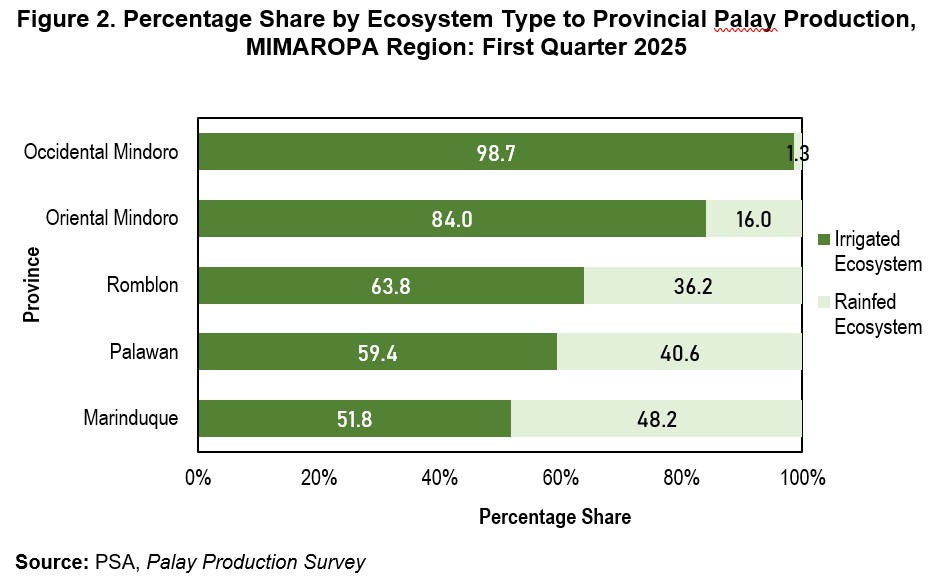
Volume of palay production up by 12.6 percent
MIMAROPA Region’s palay production of 278,462 metric tons from January to March 2025 was higher by 31,206 metric tons or 12.6 percent than the estimated 247,255 metric tons of palay produced in the same quarter of 2024. Among provinces, Occidental Mindoro posted the largest increase of 16,430 metric tons or 55.3 percent upsurge from the estimated 29,700 metric tons production in the first quarter of 2024. Oriental Mindoro followed with an increase of 8,064 metric tons or an additional 10.8 percent relative to their respective production of 75,017 metric tons relative to the same quarter of 2024. Palawan ranked third with an increase of 3,648 metric tons from the same quarter of 2024. (Figure 3 and Table 1)
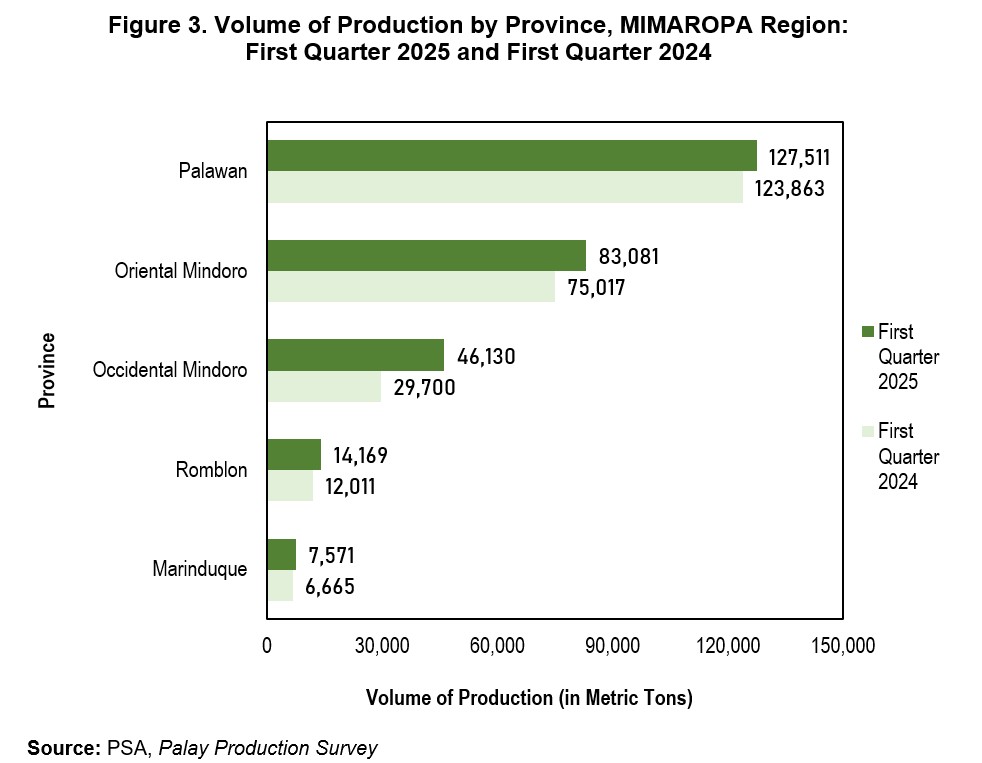
Palay production from the irrigated ecosystem in the first quarter of 2025 reached 204,005 metric tons, marking a 16.9 percent increase compared to the production of 174,549 metric tons during the same period in 2024. This growth was primarily driven by 16,510 metric tons upsurge in palay production in Occidental Mindoro. Oriental Mindoro followed, with an increase of 7,779 metric tons from the 62,037 metric tons during the first quarter of 2024. Romblon and Palawan also posted an increase of 2,663 metric tons and 2,293 metric tons, respectively. (Figure 4 and Table 1)
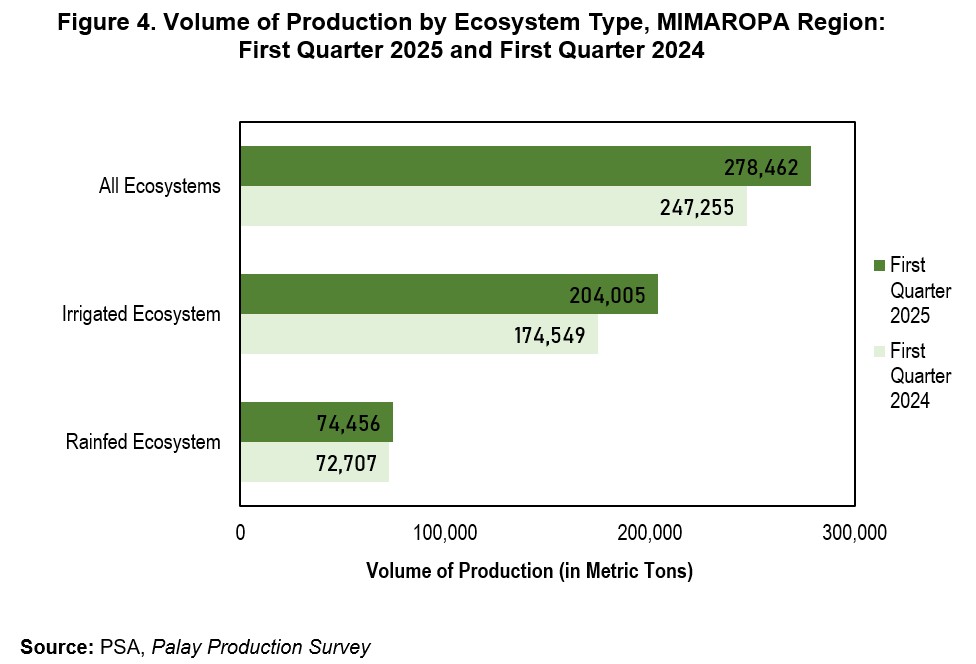
Similarly, palay grown and harvested from the rainfed ecosystem during January to March 2025 exhibited a slight increase of 2.4 percent at 74,456 metric tons from 72,707 metric tons during the first quarter of 2024. This was contributed by the increase in the production of palay from rainfed farms in Palawan (1,355 metric tons), Marinduque (694 metric tons), and Oriental Mindoro (285 metric tons). (Figure 4 and Table 1)
Total palay area harvested expands by 6.0 percent
The total area harvested for all palay ecosystems during January to March 2025 in the MIMAROPA Region reached 68,999 hectares. Among provinces, Palawan recorded the largest area harvested at 32,259 hectares, which translates to a 46.8 percent share to the regional area harvested. Oriental Mindoro and Occidental Mindoro followed with corresponding estimated area harvested of 20,738 hectares (30.1% share) and 9,850 hectares (14.3% share). Meanwhile, the area harvested from Romblon and Marinduque lagged at 3,830 hectares (5.6% share) and 2,322 hectares (3.4% share), respectively. (Figure 5 and Table 2)
The regional total area harvested exhibited a 6.0 percent increase or an expansion by as much as 3,909 hectares compared to the recorded harvested area of 65,090 hectares from the first quarter of 2024. Occidental Mindoro led in the increase of the region’s area of land on which palay were grown and harvested with more than 2,670 hectares. Palawan and Oriental Mindoro followed with a reported increase of 544 hectares and 406 hectares, respectively. (Figure 5 and Table 2)
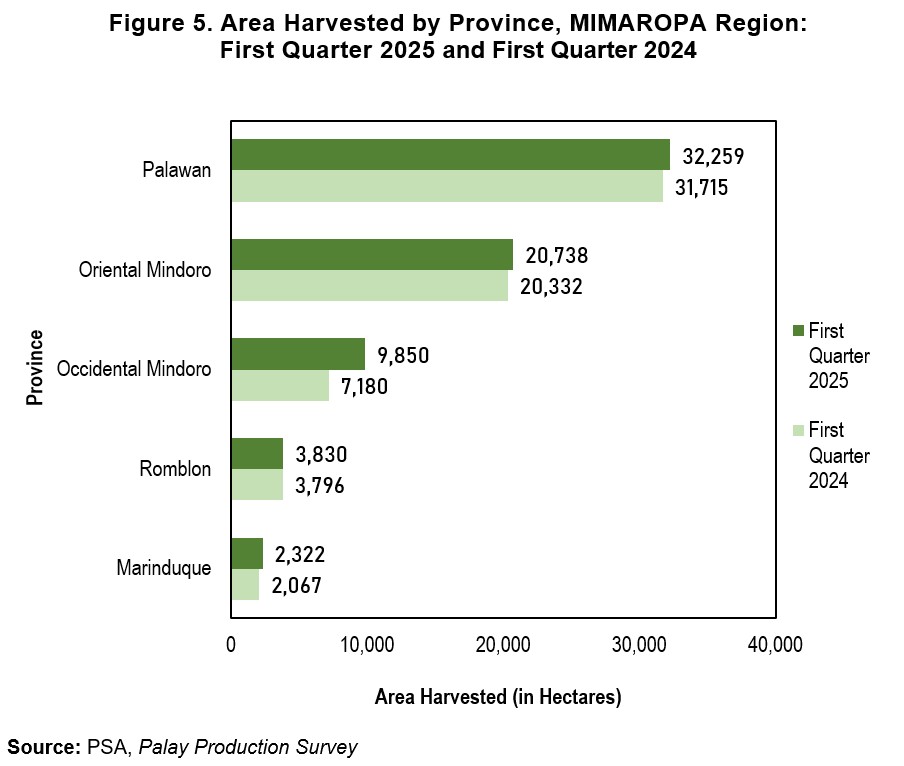
During January to March 2025, an increase in the region’s area harvested on irrigated ecosystems was noted relative to the first quarter of 2024. A total of 3,882 hectares were added to the irrigated ecosystem’s area harvested, which translates to an increase of 8.9 percent. The expansion in the area harvested was contributed by Occidental Mindoro (2,792 hectares), Oriental Mindoro (354 hectares), Romblon (348 hectares), and Palawan (346 hectares). (Figure 6 and Table 2)
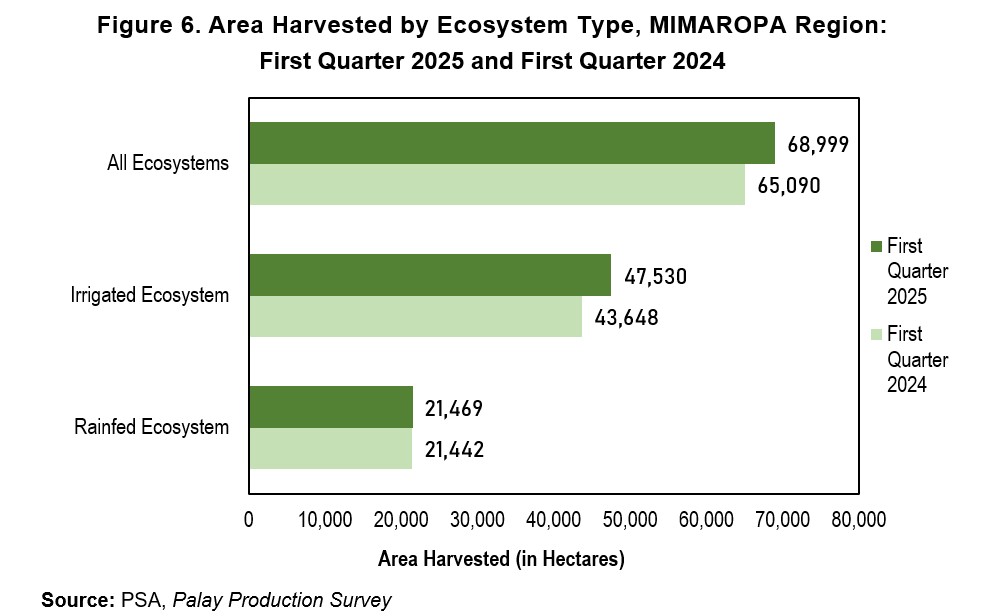
A slight uptrend in the region’s area harvested on rainfed ecosystem by 27 hectares was noted relative to the first quarter of 2025, which translates to an increase of 0.1 percent. The expansion in the area harvested was contributed by Marinduque (213 hectares), Palawan (198 hectares), and Oriental Mindoro (52 hectares). (Figure 6 and Table 2)
The average palay yield registered at 4.04 metric tons per hectare
The annual average palay yield of the MIMAROPA Region during January to March 2025 was registered at 4.04 metric tons per hectare. Among provinces in the region, Occidental Mindoro posted the highest average yield at 4.68 metric tons per hectare. In addition, this was the only province that exceeded the regional average yield. Meanwhile, Marinduque’s annual average yield of 3.26 metric tons per hectare posted the lowest average yield. (Figure 7 and Table 3)
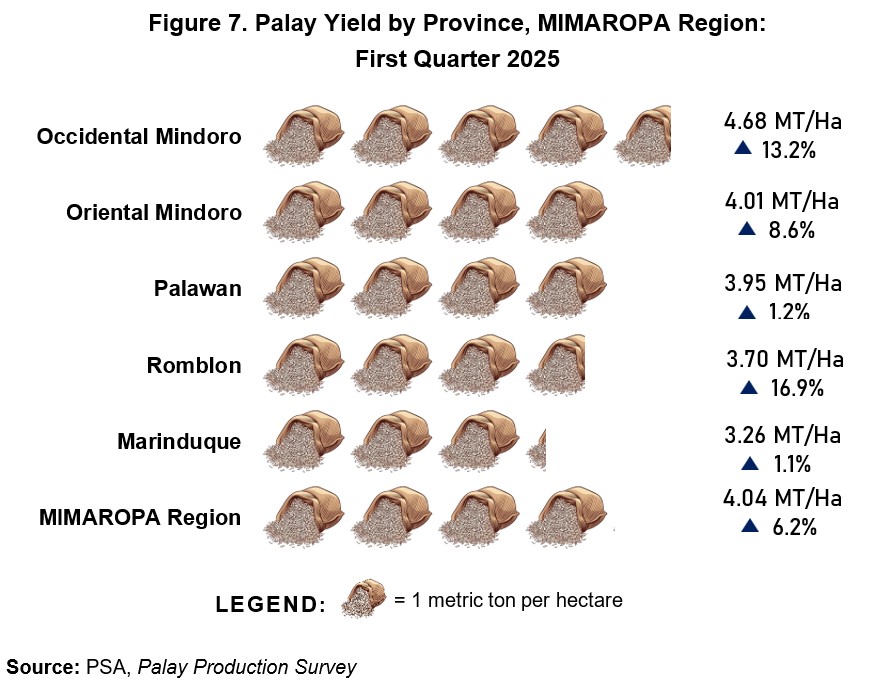
With respect to the average palay yield during the first quarter of 2024, the regional average yield went up by 0.24 metric tons per hectare or 6.2 percent. This was contributed by the increase in the average yield in Occidental Mindoro by 0.55 metric tons per hectare (13.2%), Romblon by 0.54 metric tons per hectare (16.9%), Oriental Mindoro by 0.32 metric tons per hectare (8.6%), Palawan by 0.05 metric tons per hectare (1.2%), and Marinduque by 0.04 metric tons per hectare (1.1%). (Figure 7 and Table 3)
(SGD) LENI R. RIOFLORIDO
Regional Director
MLLM / RRL / RSS

